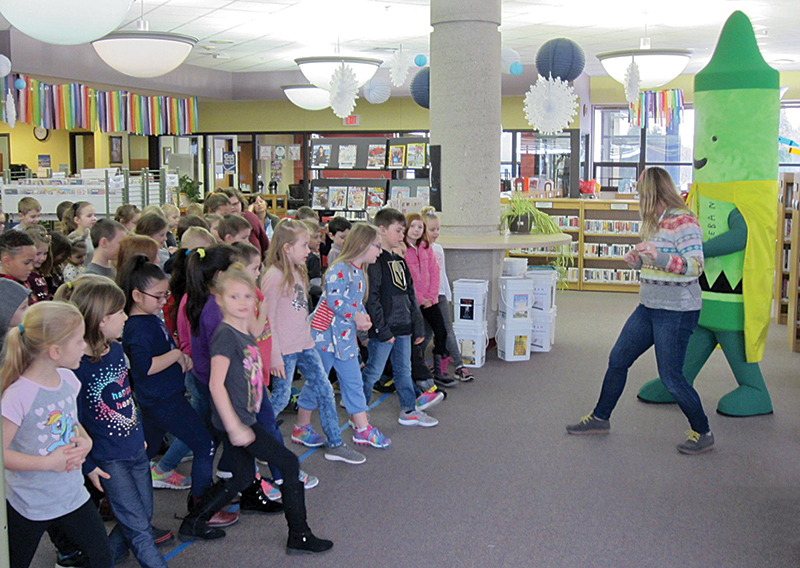How Does a Shared School and Public Library Work? Take a Look at Mine.
A partnership between your public library and the public school district makes sense. Both organizations can save money by sharing space, personnel, and collections.
 |
Crayons Storytime at the Julia Hull District LibraryPhotos courtesy of Julia Hull District Library |
A partnership between your public library and the public school district makes sense. Both organizations can save money by sharing space, personnel, and collections. Both can reach out to new patron groups through shared programming and marketing and leverage their partnership when it comes to advocacy and grant writing. What’s not to like? Julia Hull District Library (JHDL) and its community school district, Meridian CUSD 223 in Stillman Valley, IL, imagined such a partnership in 2002 when JHDL built a new joint-use facility attached to the existing public high school. The partnership has strengthened over time, but it hasn’t always been easy, and the benefits don’t come without challenges. Before making the leap into a partnership, it’s important for decision makers to understand the sometimes complex issues at hand. In my 10-plus years as library director, the issues that require the most consideration are space, collection building, personnel, and programming and marketing.
SPACE: Joint-use libraries take various approaches to designing and using space. JHDL is 7,500 square feet, with two entrances: one for students, faculty, and support staff, and a separate entrance (and exit) for the public. There are separate computer banks for students and public patrons to use during school hours, as well as a community-only area in a large open space shared by public and school users throughout the day. Important questions to consider: Will school and public patrons commingle, as ours do? With two entrances, how will your library prepare for and protect against potential security threats? How will school vs. community-access computers manage content during school hours?
Also read: Two Libraries In One: When Schools and Public Libraries Share Space, All Users Benefit
 |
The teen advisory council |
COLLECTION BUILDING: Talk about collection development in a joint-use facility often leads with content. How can we avoid censorship, protecting children from inappropriate content but not limiting patron access? How will partners contribute to collection development and management? In the event of a breakup, who takes what? JHDL labels materials with differently coded barcodes.
PERSONNEL: Public and school libraries may have vastly different qualifications for their employees. In the case of JHDL, the partnering organizations require their director librarian—that’s me—to possess an ALA-accredited MLS and a secondary teaching certificate. Will your head librarian be working one-on-one with students, in a classroom setting, writing curriculum, or providing bibliographic instruction? If not, then a secondary teaching certificate may not be necessary. Decision makers also need to agree about who pays whom. JHDL’s public funds cover the cost of all publicly hired employees, while the school district covers the cost of a 10-month, full-time school aide. The director is hired through the school district, which covers 40 percent of salary and benefits, while the public library district covers the rest. But who has authority to evaluate shared employees? What happens if one party wants to eliminate a position or let someone go?
PROGRAMMING AND MARKETING: Among the joys of a joint-use library is seeing multiple generations of users engaged in library activities. At JHDL, it’s not uncommon to see an adult discussion group, a storytime, and a class of students working on a research project, all at once. Imagine: A group of adults sings “What Shall We Do with Lazy Katie?” to babies in the children’s area while high school students type on Chromebooks, nodding along with the music. Such activities create community. Joint libraries can leverage that sense of community to market events and programs on each other’s social media, connect with teachers across facilities via school email, and provide outreach opportunities for students.
A partnership’s success is contingent on thoughtful preparation. So, have a plan. First, identify the reasons to partner. One or both parties may save money, but that can’t be the only reason to collaborate. Both parties must share common goals and objectives. Clearly define policies and procedures in a legal agreement (IGA or MOU).
Prioritize communication, which builds trust. Hold periodic in-person meetings with school and public representatives and board members. Revisit your IGA or MOU and amend as needed. A joint-use library can benefit all parties—but only if those parties are willing to commit and advocate for the relationship.
Joanna Kluever is director of the Julia Hull District Library.
RELATED
The job outlook in 2030: Librarians will be in demand
The job outlook in 2030: Librarians will be in demand
ALREADY A SUBSCRIBER? LOG IN
We are currently offering this content for free. Sign up now to activate your personal profile, where you can save articles for future viewing






Add Comment :-
Comment Policy:
Comment should not be empty !!!